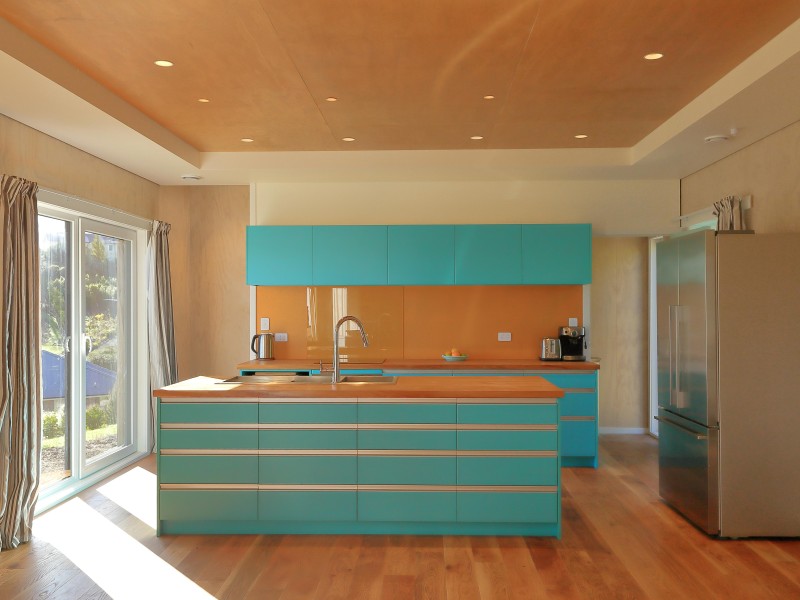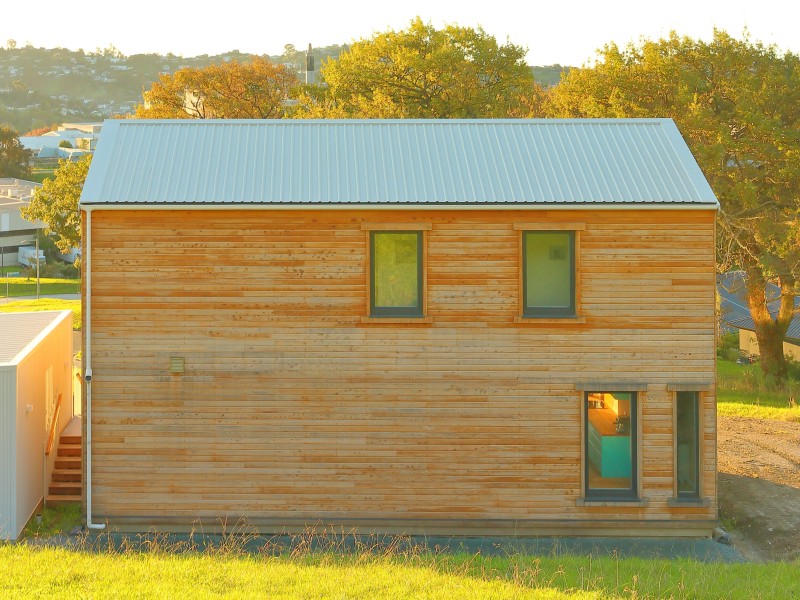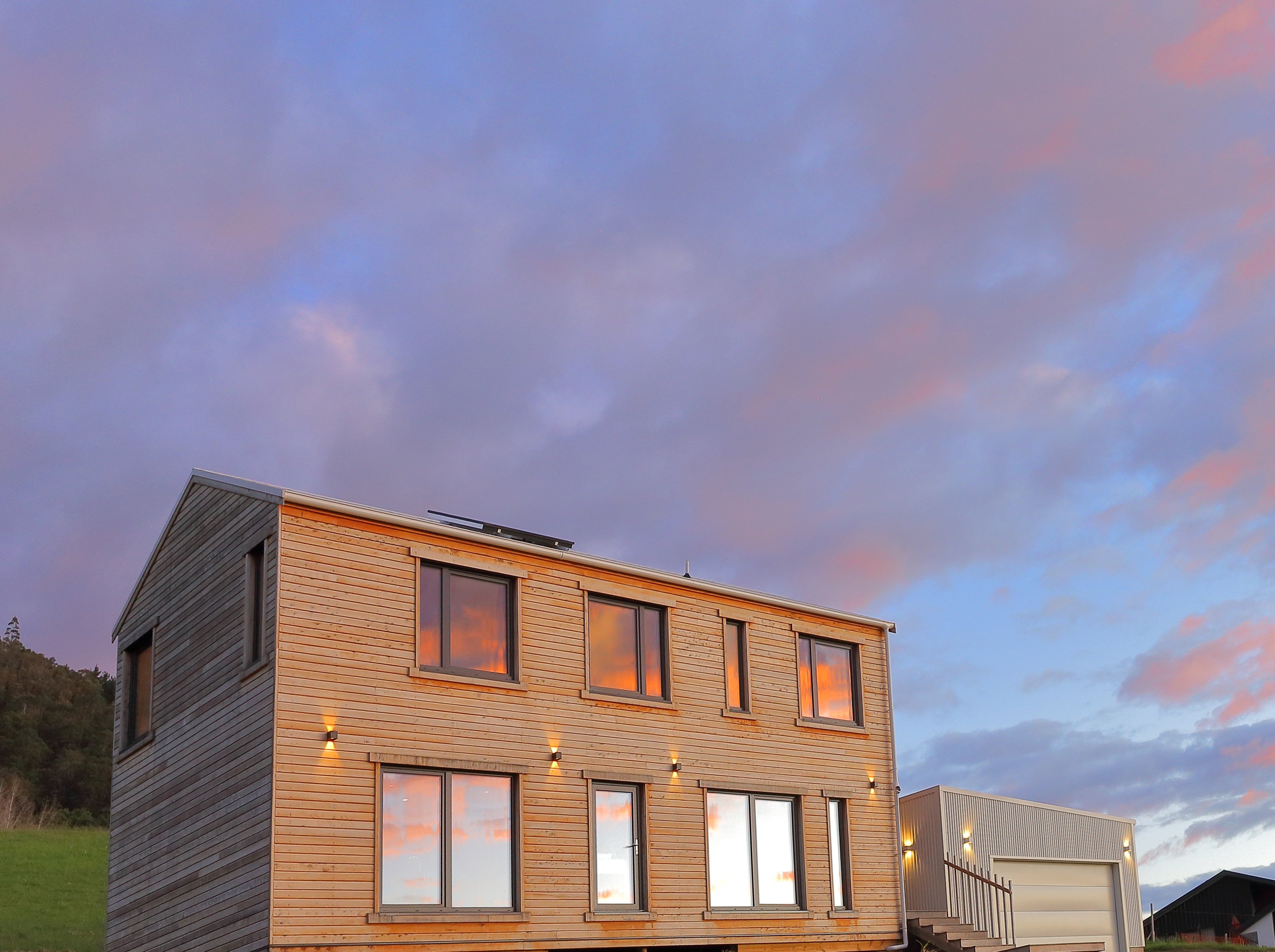Architect, Homestar Assessor and Homeowner Nathan Edmondston had green intentions from the outset when he purchased a plot of land in Nelson with his partner Yuki Fukuda. Dedication and resilience has seen the couple achieve a new gold industry standard for sustainable building in Aotearoa, recently being awarded the country’s first 10 Homestar Built Rating under the new version 5 for their Nelson home.
Essentials
Owner: Nathan Edmondston, Yuki Fukuda.
What: Three-bedroom, two-bathroom house with a standalone garage.
Location: North-facing inner-city section.
Configuration: Living, dining, kitchen on the ground floor with bedrooms on the upper floor.
Where: Nelson South, Nelson.
Occupancy: Two adults and one child.
Project certification: 10 Homestar Built Rating 2023.
Project Snapshot
Architect: Nathan Edmondston.
Main contractor: Basham Building.
Structural Engineer/Prefabrication: Potius Building Systems Ltd.
Homestar assessor: Nathan Edmondston.
Project timeline: section purchased February 2020, completion of design April 2021, completion of construction June 2022, move in June 2022.

Nathan Edmondston and Yuki Fukuda had green intentions right from the outset when they purchased a plot of land in Nelson.
“We wanted to live in a house that reflects our values. It was really important for us to be able to demonstrate to others that it is possible to build a house that is low impact, as ambitious as the Zero Carbon Act targets and be all-round sustainable. Living lightly in terms of our ecological footprint - we believe this is the way forward to ensure all of our children have a thriving future on this planet,” says Yuki.
Nathan was determined to achieve a 10 Homestar rating, as an architect who actively promotes sustainability as part of his practice, the rating was his way of walking the talk. Key to his design intention was to create a low carbon, all-round sustainable and warm home. Nathan notes “Whilst this sounds simple, this lens filters through every aspect of the design – window sizes, floor-to-floor heights, construction modules.”
Green highlights include:
- Triple-glazed windows. Significantly improving the performance of the house, warmth and acoustics.
- Local materials – materials were sourced from the Nelson/Tasman region where possible.
- Prefabrication – choosing offsite prefabrication for the build process saved time and money and minimised waste.
- Heat recovery units.
- Thick timber walls with a lot of insulation in the wall, floor and ceiling and an airtight layer.
- Minimal use of concrete – reducing carbon heavy products.
“The green features make our lives easier. I used to spend a lot of time wiping condensation on single or double-glazed windows every winter morning and dealing with mouldy curtains. Now I can spend the time and money saved on plant propagation and other activities that empower our communities and greening the planet,” says Yuki.
Their power bill is very low, sitting at around $100 per month during the winter, using less than 300kW/h. That price includes EV usage, and the carbon offset fees they pay. Thanks to the airtightness and great level of insulation, their home sits at a pleasant resting temperature of 21-24 degrees Celsius.
“The house is so efficient at keeping the warmth in that simply using an oven for cooking dinner and having a shower was enough to keep the house warm on cloudy/rainy days,” reflects Nathan. They haven’t had to turn a heater on this past winter at all.

Prefabrication was a conscious green choice for this building. Andy Van Houtte is the director of Potius Building Systems, responsible for the structural engineering and prefabrication on the project. Potius focuses on minimising the embodied carbon in their materials, choosing to source the majority of their timber from an 80km radius within the Nelson region, lowering transportation footprints.
Potius also optimize the design structurally to use the least number of materials possible, reducing waste. Minimizing the amount of timber and thermal breaks and bridges used in the building also maximises the thermal performance of the building. “Because we use all the offcuts, there isn’t much waste. Building in a factory means we have more control about how and when products are used,” Andy explains.
Lenny Basham and his team at Basham Building were the main contractors on the project.
“We took on the project because it reflects our values of building something to a high-quality standard that will have good longevity and health benefits for its occupants,” Lenny says.
“To see it independently audited and receive a 10 Homestar rating is impressive, and a great affirmation of the work we’ve done.”
Hindsight provided Nathan and Yuki with the realisation that taking more photo evidence for Homestar submission would have been a good idea, and the importance of discussing the intention to build to Homestar early in the process – making sure everyone has a shared goal.
The team at Potius did not find the requirements of building to Homestar too challenging, largely thanks to their system fitting the requirements already. “We had to adapt a few things slightly and had extra considerations and accuracy around airtightness and the design and construction of the double stud wall which was perfectly thermally broken,” says Andy.
Lenny’s experience left him wishing Homestar was standard practice. “If I could build to Homestar 10 and Passive House full-time it’d be a no-brainer. It would be awesome if we one day can make it regulation, I don’t think it's hard to do, people just need to commit,” he says.
Nathan and Yuki are incredibly humbled by their home’s 10 Homestar rating and hope they can share what they have learnt with others. They have long-term plans for an inner-city permaculture food farm, having already planted over 40 fruit trees and 380 natives. Not only will their home be sustainable, but they will be able to improve the resilience of their local community.
Nathan and Yuki hope that one day everyone in New Zealand can live in a home as warm, dry and sustainable as theirs.
“Too many people living in Aotearoa have to deal with cold and damp houses. A house is one of the biggest purchases in your life - you would want to know that it is built well, will keep you warm and dry, and is backed up by scientific evidence. It is our hope that everyone gets to live in a Homestar rated house - housing is a basic human right,” says Yuki.

